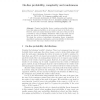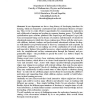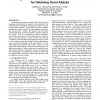506 search results - page 75 / 102 » Learning Event Durations from Event Descriptions |
ALT
2008
Springer
15 years 8 months ago
2008
Springer
Abstract. Classical probability theory considers probability distributions that assign probabilities to all events (at least in the finite case). However, there are natural situat...
SCHULE
2007
Springer
15 years 6 months ago
2007
Springer
: In our department we have a long history of developing interfaces for learning, which are framed by constructivist and constructionist theories of learning. Thus we try to create...
109
click to vote
KDD
2002
ACM
16 years 7 days ago
2002
ACM
Traditional intrusion detection systems (IDS) detect attacks by comparing current behavior to signatures of known attacks. One main drawback is the inability of detecting new atta...
JCNS
2000
14 years 11 months ago
2000
Abstract. The electrosensory lateral line lobe (ELL) of mormyridelectric sh is a cerebellum-likestructure that receives primarya erent input from electroreceptors in the skin. Purk...
COGSCI
2002
14 years 11 months ago
2002
Much of cognitive psychology focuses on effects measured in tens of milliseconds while significant educational outcomes take tens of hours to achieve. The task of bridging this ga...



